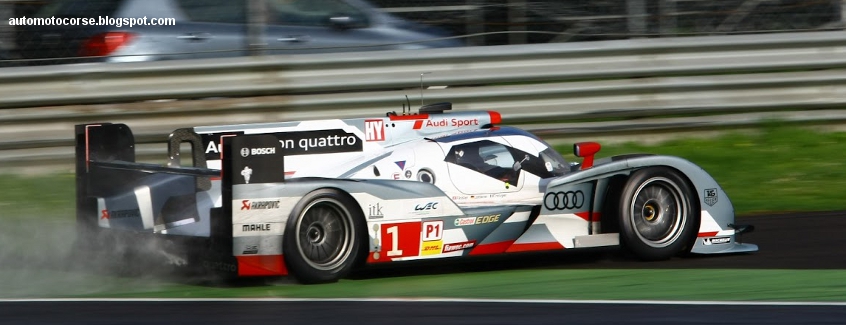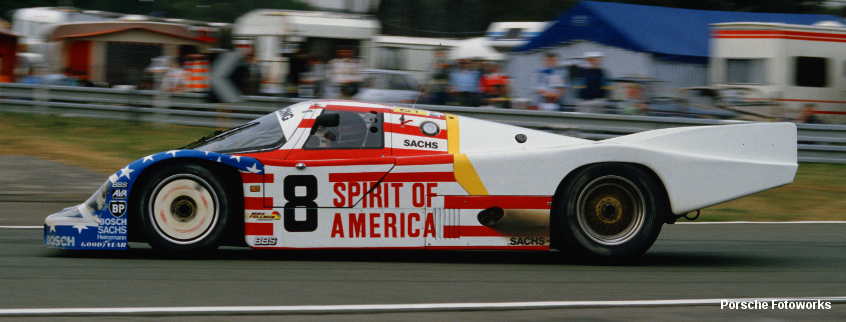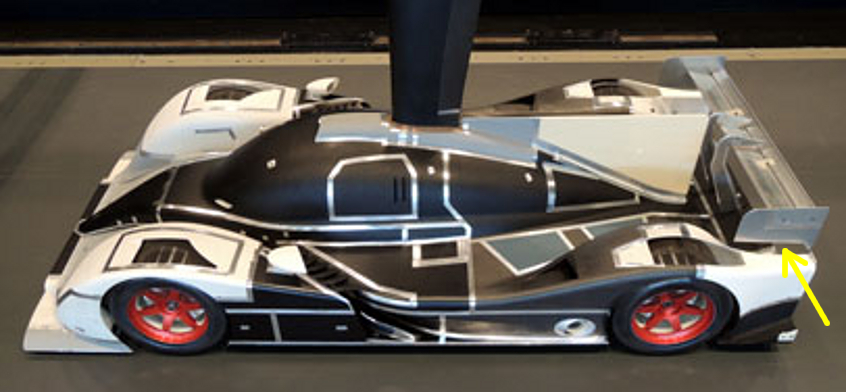|

|
Pete
Lyons' fantastic Can-Am Cars in Detail:
 |
March/April 2013
Reload
to see the latest news
All news content copyright Michael J. Fuller, unless
otherwise noted |
 |  4.25.13 4.25.13
>>Of
course everyone knows the current regulations (ACO2004) limits the
rear overhang dimension to 750 mm. And Audi's R18 is designed taking
into account that maximum dimension. But with the rear wing out to 750
mm, Audi had offset the engine cover bodywork a few inches forward such
that the bodywork and the rear wing weren't on the same plane at 750
mm, creating a staggered trailing edge. And with the bodywork so
follows the diffuser, per the regulations. |  So Audi has been testing at Monza with their Le Mans bodywork. The primary feature of note is that Audi has extended the rear bodywork out to the
750 mm maximum. That means the engine cover is a whopping ~138 mm longer
(roughly 5.4"). I suppose that makes it a “long tail.” I guess it's
all relative. So Audi has been testing at Monza with their Le Mans bodywork. The primary feature of note is that Audi has extended the rear bodywork out to the
750 mm maximum. That means the engine cover is a whopping ~138 mm longer
(roughly 5.4"). I suppose that makes it a “long tail.” I guess it's
all relative.
| And with my grumpy pants firmly on, here are some REAL long tails. I feel bad for today's generation...
WM Peugeot P88 (1988) |  Porsche 956 Long Tail (1986) Porsche 956 Long Tail (1986) |  And the ultimate... And the ultimate...
Porsche 917 Long Tail (1970) | |  4.21.13 4.21.13
>>A
rumor began circulating at Silverstone last week that Audi was
utilizing a blown diffuser aero solution. The source of this
rumor turned out to be none other than Toyota, so it came with the
credence of the one outfit who's probably looked hardest at the Audi
but that also had a working knowledge of what could and couldn't be
done within the regulations given their own LMP1 design and build (and
usually suggests they themselves are contemplating the same).
Now,
the idea to do a blown diffuser has been kicked around for some time,
the problem is the regulations limit the openings into the
underfloor. Looking at that governing document,
Article 3.5 states that the only openings allowed in the floor are for
the air jack, ride height sensors, a maintenance hatch, the fuel
overflow pipe, as well as the normal openings for tire clearance.
So for all the potential desire to utilize the aerodynamic benefit of
an activated diffuser (and of course there are some draw backs as
well), right out of the gate there's that one stumbling block about how
to even go about it.
The rumor was pretty specific and
mentioned the possibility of blowing the exhaust into the wheel
well. That's interesting...But the first obstacle for Audi was
the single exhaust layout they have for their single turbo. And
over the course of the Silverstone race weekend confirmation came (via
Race Car Engineering's man on the scene Andrew Cotton) that Audi had
actually split their exhaust into two...
When you're on the back
end of a known change without an obvious reason, usually there's a
primary driver upstream some where. A little more prodding and an
admission that Audi were doing something aerodynamic with the exhaust
came spilling out and Toyota's suspicion was right after all (Audi
sources wouldn't tell Cotton where they poked out of the car only to
say it, “helps with the air behind the car, reducing drag.”).
But
first things first, what about the effective mass-flow from the turbo
diesel exhaust pipe, surely there's not enough velocity to the exhaust
after its tour of the exhaust impeller to do anything worth
while? Or, at least that had been the thought for some
time. But sources told me that apparently, “...there's
enough.”
So, with it established that there is enough
mass flow energy from the diesel exhaust to use it for an aerodynamic purpose but that you can't directly
plumb the diffuser, so what can you do with it? A little more reading of the
regulations took me back to the allowed openings and what Toyota was
saying, wheel wells. The thought then fixed on, “...minimum gaps
necessary for wheel and suspension part movements.” If you can't
add any new holes, why couldn't you use any legal existing ones?
For instance, could the exhaust be fired out the openings in the floor
for wheel clearance? How could that work? What about via
the Coanda effect? Was it possible to wick the exhaust stream up
into the diffuser from the wheel well openings and influence the
diffuser that way?
That
might be overstepping the
possibilities too much and for now I don't think that's what Audi is
doing. I get the idea that they're doing something more
pedestrian such as using the exhaust to fill in behind the rear wheel
wake. This is mainly based on what sources told Cotton. I
have confirmed that the exhaust is in close proximity to the rear tire
and the
comment was made that for now the exhaust heat isn't having any effect
on the tires. But this only confirms the general area where the
exhaust is
going, not what's being done with it.
At Sebring this year it
was observed throughout the weekend that the two Audis had distinctly
different exhaust notes. When I asked, in retrospect, if the new
exhaust layout had been on the car as far back as Sebring I did receive
confirmation that yes it was; the way the exhausts are plumbed and
where they exit the car imparts a much more aggressive engine
note. So Audi had previously race tested the new layout well prior to
Silverstone.
On
a related note, it was pointed out that
Audi's fuel consumption strategy was drastically different at
Silverstone this year as compared to last year. Compared to last
year, Audi's consumption increased a substantial percentage,
15%+. And with the rumors circulating about an exhaust activated
diffuser, and with the knowledge of how their use in F1 led to higher
fuel consumption (and the FIA banning those systems on those grounds),
it was assumed that this was another indicator of what Audi was up
to. Remember, F1 teams ran special fuel maps that would dump fuel
into the exhaust in off throttle moments in order to keep exhaust flow
velocities up given the aerodynamic benefits. But I've inquired
along those lines and have been told that you can't simply burn
additional diesel fuel in the exhaust system to keep off-throttle mass
flow up as it has a ruinous effect on the exhaust impeller, not to
mention the difficulty of igniting diesel fuel. So let's stress
this: signs of increased fuel consumption by the R18 relative to
last year is NOT indirect evidence of a blown diffuser. The
indirect evidence of aero manipulation utilizing the R18's exhaust is
what's been shown above, the increased fuel consumption another matter
entirely.
This
further leads me to think that Audi aren't directly activating (via
something fancy like Coanda, if it's even possible) the diffuser given
that limitation and are instead concentrating on less sensitive areas.
So, now you know what to look for, or at very least where to poke your head, pictures please! | 
|  4.9.13 4.9.13
>>Dome's been quiet as of late but a few images have landed on a Japanese language blog.
These appear to show the existing S102.5 wind tunnel model with
developments intended for the S103. Back in February Dome
indicated that they would be in the wind tunnel with a 2014-compliant
model by mid-March and be in a position to reveal images by (perhaps)
May some time. The shot here (substantially enlarged) shows
nothing particularly new but for a new long endplate (arrow) that
doesn't connect to the rear fender (per S102.5)...
|  >>Antonio Pannullo has some really nice posters available. >>Antonio Pannullo has some really nice posters available. | 
|  3.29.13 3.29.13
>>Responding to the pressure to produce something of the new Lotus T128, here are a few quick images with some yellow stickies on them...
(1)
Rear brake ducts (which we've just been able to make out in that image
Lotus released in August last year of their wind tunnel model).
(2) More than likely a cooling duct for the LED headlights.
Of note will be the 2014 monocoque (slightly larger due to required vision templates) and subsequently altered cockpit position.
Lotus has opted to go with the open/slotted front splitter.
While
this has elements of a 2014 car in place (tub), I can't be certain it
meets all the 2014 criteria given the 2013 regulations. For
instance, I can't be sure if we're looking at a 1900 mm wide car.
I'd have some doubts Lotus would run a 2000 mm wide (2013 legal)
car and then chuck or modify those items (suspension, bodywork) less
than a year later to run to the (between) 1900 and 1800 mm new
maximum width. But the car above does appear to be running to 2013
rear wing width regulations (1600 mm wide) as the 2014 difference
between the width of the wing and overall car width would be no more
than 50 mm each side (1800 mm wide rear wing, 1900 mm wide car if drawn
to max dimension). The difference above looks a lot larger than
that and closer to 2013 offsets (around 200 mm each side, without wing
extensions of course). So based on that I'd have to say that
indeed the car is running to 2013 rear wing width rules at very least
(1600 mm), and perhaps 2014 bodywork rules, thus ~1900 mm width, as it
just doesn't make sense to run bodywork, etc. eligible for only one
year and then have to figure a way to make 2" (50 mm) each side
disappear. |  Noticed
this gap on the engine cover's trailing edge, at first I wasn't sure
what to make of it. My gut reaction is that it's simply a stick
on/bolt on camber change bit for the trailing edge, not too dissimilar
to this item on the HPD ARX-01e LMP. Here's another shot showing that the opening is slotted, but for now I don't think it's that significant (I don't think it's an air passage of any kind. For now.). Noticed
this gap on the engine cover's trailing edge, at first I wasn't sure
what to make of it. My gut reaction is that it's simply a stick
on/bolt on camber change bit for the trailing edge, not too dissimilar
to this item on the HPD ARX-01e LMP. Here's another shot showing that the opening is slotted, but for now I don't think it's that significant (I don't think it's an air passage of any kind. For now.). | 
|  3.16.13 3.16.13
>>The
mystery surrounding Audi's new hybrid engine system gets a bit
clearer...it has been verified that my speculation was correct inasmuch
as yes, the now-you-see-it-now-you-don't bulge (1) in the engine cover
is related to a new hybrid engine system that Audi has been running in
testing. It was the source of that odd engine note everyone heard
out of the Audi in testing at Abu Dhabi.
As
I mentioned back on March 9 (see below), the FIA has weighed in and as
a result the system has actually been effectively banned. And it
sound as though it won' t necessarily be eligible next year.
While I would suspect at this point Audi and the FIA would be
attempting to work this out, I'm being told as I write this that this
is it and the system will not be raced at all.
Though it's hard to imagine Audi would walk away that easily from
what I'm told has been 15 months of R&D. Watch this space?
So,
what is (was) the new mystery hybrid system? I hear through the
grape vine that it is an "Air Hybrid" system and understand that it
works like this: a compressed air reservoir is charged by the
engine cylinders during braking/coasting and then released on
acceleration, eliminating turbo lag. The beauty is that it
augments the engine without the need for heavy, environmentally
unfriendly, batteries. Peugeot-Citreon is currently developing a
similar system for their road cars with the intention to introduce it
in the near future. So there is immediate relevance (there's that
word) to mass-produced road
cars, quite unlike Audi's flywheel system currently being used to
recharge the R18's batteries, or any hybrid system being raced on any
race car in LMP or F1 for that matter. That's where that
"relevance" term sticks in my craw: show me relevance to mass-produced
cars and I'll be happy.
It's my understanding the contention
with the FIA regards when the compressed air system opens and adds air
to the reservoir as apparently it allows boost reduction once the
restrictor flow limit is reached. Of course this isn't an issue
under 2014 rules as inlet restrictors are eliminated next year in lieu
of fuel flow restrictors, so perhaps there's more to the story. | 
|  3.9.13 3.9.13
>>Audi's
PR machine has started to warm up with Sebring only a few days away.
The take away are computer renders of the 2013 Audi R18. Those
are interesting as they show Audi's execution of the not-so-clever rear
(why "not-so-clever" you ask? See my August 25
entry) wing extensions (1). Last year Audi insiders
intimated that they too had wind tunnel tested a similar solution
as early as late 2011. They were described as "draggy" then
(considering Toyota were using them and it was agreed they probably
were giving up horsepower, it didn't necessarily make sense...but if
they had less drag to begin with...this is just a side point), but with
all of last season and an off season to develop, can we assume their
(small I'm sure) drag penalty has been eliminated now that they are on
the 2013 Audi? Let's hope so as Audi is now only claiming 490 hp
(*wink wink*) for the 2013 R18...
The other thing I noticed was that the bulge seen in the engine cover
(2) back in January is gone. Significant? Initially I was
told that it was there because the exhaust was re-routed at the rear of
the car, so it's elimination was potentially noteworthy (you just don't
change something like that then change it back). Yes, I did
considered a reworking of the engine cover surfaces as a likely answer.
But then there was a report at Sport Audi
that caught my eye because it mentioned a "system" that Audi was
intending to use this season had been "banned" by the FIA. There
was no mention at all anywhere as to what this system was and inquiries
along those lines generated silence. But now I'm understanding
that there is a connection to the eliminated engine cover bulge and
the "banned" system. A little more digging and it turns out the
system, whatever it is, wasn't banned; the FIA simply tweaked the
parameters along which its performance was calculated and thus it
became nonviable. Our guess is that it was an exhaust gas energy
recovery system...
Oh, it would also appear that Audi will be
running a 2012 spec car alongside a 2013 car at Sebring based on the
renderings they've released of the 2013 Sebring liveries (the #1 car is
in 2012 spec, the #2 car in 2013 specification).
| | 3.5.13
>>These
have sat around for far too long without any analysis. At this
point I can't be bothered to compare this latest update (the latest
that are in my posession) to the previous update of the ACO2014 rules (10.15.12 entry),
so here they are. And the 2013 rules have been on the ACO's site
for some time, I'm posting them here for the first time.
2014 LMP1 V05 regulations
2013 LMP 1 & LMP2 regulations |

|
|

